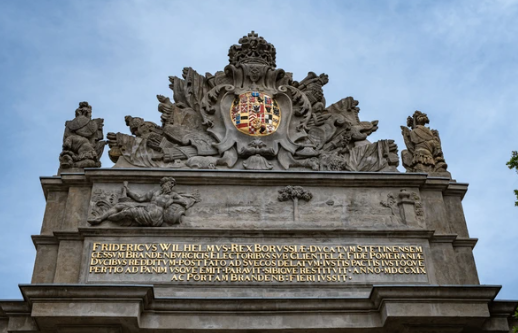Introduction: The Birth of a Duchy That Shaped European History
The establishment of the Duchy of Brandenburg in 1180 marked the beginning of a significant chapter in the history of what would become one of the most powerful states in Europe. The duchy, which later evolved into the Margraviate of Brandenburg and eventually the Kingdom of Prussia, played a crucial role in shaping the political, cultural, and military landscape of Central Europe. The foundations laid in 1180 set the stage for the rise of Brandenburg as a key player in the Holy Roman Empire and laid the groundwork for its future expansion and influence.
Read Also : The German Territories and the Nine Years’ War (1690): A Period of Turmoil and Transformation
The Historical Context: The Holy Roman Empire in the 12th Century
The 12th century was a period of significant change and development within the Holy Roman Empire. The empire, which encompassed a vast and diverse territory across Central Europe, was characterized by a complex system of feudal relationships and a constant struggle for power between the emperor, the nobility, and the church. The establishment of the Duchy of Brandenburg was part of the broader process of territorial consolidation and political realignment that was taking place within the empire during this time.
The Fragmentation of the Saxon Stem Duchy
Before the establishment of the Duchy of Brandenburg, the region was part of the larger Saxon Stem Duchy, one of the original duchies of the Holy Roman Empire. The Saxon Stem Duchy was a powerful and influential entity, but it was also characterized by internal divisions and conflicts between its various noble families. These divisions ultimately led to the fragmentation of the duchy in the late 12th century.
In 1180, Emperor Frederick I Barbarossa, seeking to weaken the power of the Saxon Duke Henry the Lion, decided to break up the Saxon Stem Duchy into smaller, more manageable territories. As a result, the Duchy of Saxony was significantly reduced in size, and several new duchies and territories were created, including the Duchy of Brandenburg. This division was part of Barbarossa’s broader strategy to consolidate imperial authority and to prevent any single noble from becoming too powerful.
The fragmentation of the Saxon Stem Duchy was a turning point in the history of the region, as it led to the creation of new political entities that would play a key role in the future of the Holy Roman Empire. The establishment of the Duchy of Brandenburg was a crucial step in this process, as it created a new power center in the northeastern part of the empire.
The Rise of the Ascanian Dynasty
The establishment of the Duchy of Brandenburg was closely tied to the rise of the Ascanian dynasty, a noble family that played a central role in the history of the region. The Ascanians, originally from the Harz Mountains, had already established themselves as a significant force in the eastern part of the Holy Roman Empire by the mid-12th century.
In 1157, Albert the Bear, a member of the Ascanian dynasty, was granted the Margraviate of Brandenburg by Emperor Frederick I Barbarossa. Albert the Bear was a skilled and ambitious leader, and he quickly set about expanding his territory and consolidating his power. His successful campaigns against the Slavic tribes in the region, known as the Wends, helped to secure his control over Brandenburg and to establish the foundations of the duchy.
The Ascanian dynasty’s rise to power was a key factor in the establishment of the Duchy of Brandenburg. The Ascanians were able to leverage their military strength, political connections, and strategic marriages to build a powerful and influential state. The establishment of the duchy in 1180 was a recognition of their growing power and influence within the Holy Roman Empire.
The Role of Emperor Frederick I Barbarossa
Emperor Frederick I Barbarossa played a central role in the establishment of the Duchy of Brandenburg. As one of the most powerful and ambitious rulers of the Holy Roman Empire, Barbarossa sought to strengthen imperial authority and to prevent the rise of any single noble family that could challenge his power. The fragmentation of the Saxon Stem Duchy and the creation of new duchies, including Brandenburg, were part of this broader strategy.
Barbarossa’s decision to grant the title of Duke of Brandenburg to the Ascanian dynasty was a calculated move designed to reward loyal supporters and to create a counterbalance to the power of the Saxon dukes. By elevating the Ascanians to the status of dukes, Barbarossa ensured that they would remain loyal to the empire and that they would serve as a bulwark against potential challenges to imperial authority.
The establishment of the Duchy of Brandenburg was also part of Barbarossa’s efforts to expand and consolidate the eastern territories of the Holy Roman Empire. The region that would become Brandenburg was still relatively undeveloped and sparsely populated, and Barbarossa recognized the potential for growth and expansion in the area. By creating a new duchy in this strategically important region, Barbarossa laid the groundwork for the future expansion of the empire’s eastern frontier.
The Establishment of the Duchy: A New Power in the Holy Roman Empire
The establishment of the Duchy of Brandenburg in 1180 marked the creation of a new and powerful political entity within the Holy Roman Empire. The duchy quickly became a key player in the complex and ever-changing landscape of Central European politics, and its rulers would go on to play a significant role in the history of the empire.
The Ascanians and the Consolidation of Power
The Ascanian dynasty, under the leadership of Albert the Bear and his successors, played a central role in the early development of the Duchy of Brandenburg. The Ascanians were skilled military leaders and shrewd politicians, and they were able to use their position as dukes to consolidate their power and expand their territory.
One of the key strategies employed by the Ascanians was the expansion of their territory through military conquest and colonization. The region that would become Brandenburg was still largely inhabited by Slavic tribes, and the Ascanians embarked on a series of campaigns to subdue these tribes and to incorporate their lands into the duchy. This process of expansion and colonization helped to secure the borders of Brandenburg and to lay the foundations for its future growth.
The Ascanians also focused on strengthening the internal governance of the duchy. They established a system of administration that allowed them to effectively manage their territories and to maintain control over their vassals. The Ascanians were also patrons of the church, and they used their influence to promote the spread of Christianity in the region, further solidifying their control over the population.
The consolidation of power by the Ascanians was a crucial factor in the success of the Duchy of Brandenburg. Their ability to expand their territory, manage their lands effectively, and maintain the loyalty of their vassals allowed them to build a strong and stable state that would play a key role in the future of the Holy Roman Empire.
The Strategic Importance of Brandenburg
The Duchy of Brandenburg was strategically located in the northeastern part of the Holy Roman Empire, bordering the Slavic territories to the east and the Baltic Sea to the north. This location made Brandenburg a key player in the empire’s efforts to expand its influence and control over the eastern frontier.
The duchy’s strategic location also made it a valuable ally in the empire’s conflicts with neighboring powers, such as Poland and Denmark. The rulers of Brandenburg were often called upon to support the empire in its military campaigns, and their loyalty and military strength were important factors in the success of these efforts.
The strategic importance of Brandenburg also contributed to its economic development. The duchy’s location along key trade routes, including the Baltic Sea trade and the overland routes to Poland and Russia, made it a center of commerce and trade. The Ascanians and their successors invested in the development of towns and cities, such as Berlin and Brandenburg an der Havel, which became important commercial centers in the region.
The strategic location of Brandenburg also made it a target for external threats, and the duchy was frequently involved in conflicts with neighboring powers. However, the strength and resilience of the duchy’s rulers allowed them to successfully defend their territory and to expand their influence in the region.
The Role of the Church in the Development of Brandenburg
The church played a significant role in the development of the Duchy of Brandenburg. The Ascanians were strong supporters of the church, and they used their influence to promote the spread of Christianity in the region. The establishment of bishoprics and monasteries helped to consolidate the duchy’s control over its territory and to promote the development of a Christian society.
The church also played a key role in the administration of the duchy. The bishops and abbots were important advisors to the ducal court, and they often held significant political and administrative responsibilities. The church’s influence extended to all aspects of life in Brandenburg, including education, justice, and social welfare.
The close relationship between the Ascanians and the church helped to strengthen the duchy’s internal stability and to promote its development. The church’s support was crucial in the consolidation of the duchy’s power and in the expansion of its territory. The church also played a key role in the cultural development of Brandenburg, promoting the arts, education, and the spread of Latin as the language of administration and scholarship.
The role of the church in the development of Brandenburg was a reflection of the broader relationship between the church and the state in the Holy Roman Empire. The church was a key partner in the governance of the empire, and its influence was felt in all aspects of life in the duchy.
The Legacy of the Duchy of Brandenburg: Foundations for Future Power
The establishment of the Duchy of Brandenburg in 1180 laid the foundations for the future growth and expansion of the region. The duchy’s rulers, particularly the Ascanian dynasty, played a key role in shaping the political and cultural landscape of Central Europe, and their legacy would continue to influence the region for centuries to come.
The Transformation into the Margraviate of Brandenburg
The Duchy of Brandenburg was eventually transformed into the Margraviate of Brandenburg, a title that reflected the region’s growing importance and its role as a key player in the Holy Roman Empire. The margraves of Brandenburg continued the work of the Ascanians, expanding their territory and consolidating their power.
The Margraviate of Brandenburg became one of the most powerful and influential states in the empire, and its rulers played a key role in the politics of Central Europe. The margraves were often involved in imperial affairs, serving as electors of the Holy Roman Emperor and playing a key role in the governance of the empire.
The transformation of the duchy into the margraviate was a reflection of the region’s growing importance and its role as a center of power in the empire. The margraves of Brandenburg were among the most powerful and influential rulers in the empire, and their influence would continue to grow in the centuries to come.
The Rise of the Hohenzollern Dynasty
The legacy of the Duchy of Brandenburg was further enhanced by the rise of the Hohenzollern dynasty, which came to power in the region in the early 15th century. The Hohenzollerns, originally from Swabia, were a powerful and ambitious family that would go on to play a central role in the history of Germany and Europe.
The Hohenzollerns expanded the territory of Brandenburg and transformed it into a major power in Central Europe. Under their leadership, Brandenburg became the core of the Kingdom of Prussia, a state that would go on to become one of the most powerful and influential in Europe.
The rise of the Hohenzollern dynasty was a key factor in the transformation of Brandenburg from a regional duchy into a major European power. The Hohenzollerns continued the work of the Ascanians, expanding their territory, consolidating their power, and transforming Brandenburg into a state that would play a central role in the politics of Europe.
The Long-Term Impact on German and European History
The establishment of the Duchy of Brandenburg in 1180 had a lasting impact on the history of Germany and Europe. The duchy served as the foundation for the development of one of the most powerful states in European history, the Kingdom of Prussia, which would go on to play a central role in the unification of Germany and the shaping of modern Europe.
The legacy of the Duchy of Brandenburg is evident in the political and cultural landscape of Central Europe. The region’s rulers, particularly the Ascanians and the Hohenzollerns, played a key role in shaping the history of the Holy Roman Empire and the development of the modern German state.
The long-term impact of the establishment of the Duchy of Brandenburg is a testament to the importance of this period in European history. The duchy served as the foundation for the development of one of the most powerful and influential states in Europe, and its legacy continues to be felt today.
Conclusion: The Enduring Legacy of the Duchy of Brandenburg
The establishment of the Duchy of Brandenburg in 1180 marked the beginning of a new chapter in the history of Central Europe. The duchy’s rulers, particularly the Ascanian and Hohenzollern dynasties, played a key role in shaping the political and cultural landscape of the region and in laying the foundations for the future development of the Kingdom of Prussia.
The legacy of the Duchy of Brandenburg is evident in the history of Germany and Europe. The duchy’s establishment was a key moment in the history of the Holy Roman Empire and in the development of the modern German state. The foundations laid in 1180 would continue to influence the history of the region for centuries to come.
The story of the Duchy of Brandenburg is a testament to the importance of this period in European history and to the enduring impact of the decisions and actions taken by its rulers. The duchy’s legacy continues to be felt today, as the region remains a key player in the history and politics of Europe.
FAQ About the Duchy of Brandenburg
What was the Duchy of Brandenburg?
The Duchy of Brandenburg was a territorial state established in 1180 in the northeastern part of the Holy Roman Empire. It later evolved into the Margraviate of Brandenburg and eventually became the core of the Kingdom of Prussia.
Who were the Ascanians?
The Ascanians were a noble dynasty that played a central role in the establishment and early development of the Duchy of Brandenburg. Under their leadership, Brandenburg expanded its territory and became a significant power in the Holy Roman Empire.
What was the significance of the Duchy of Brandenburg in the Holy Roman Empire?
The Duchy of Brandenburg was strategically located and played a key role in the empire’s efforts to expand its influence in the eastern frontier. Its rulers were important players in imperial politics, and the duchy became a center of trade and commerce.
How did the Duchy of Brandenburg transform into the Kingdom of Prussia?
The Duchy of Brandenburg evolved into the Margraviate of Brandenburg and later became the core of the Kingdom of Prussia under the leadership of the Hohenzollern dynasty. The Hohenzollerns expanded the territory and influence of Brandenburg, transforming it into a major European power.
What is the legacy of the Duchy of Brandenburg?
The legacy of the Duchy of Brandenburg is its role in the foundation of the Kingdom of Prussia and its impact on the history of Germany and Europe. The duchy laid the groundwork for the development of one of the most powerful states in European history.






